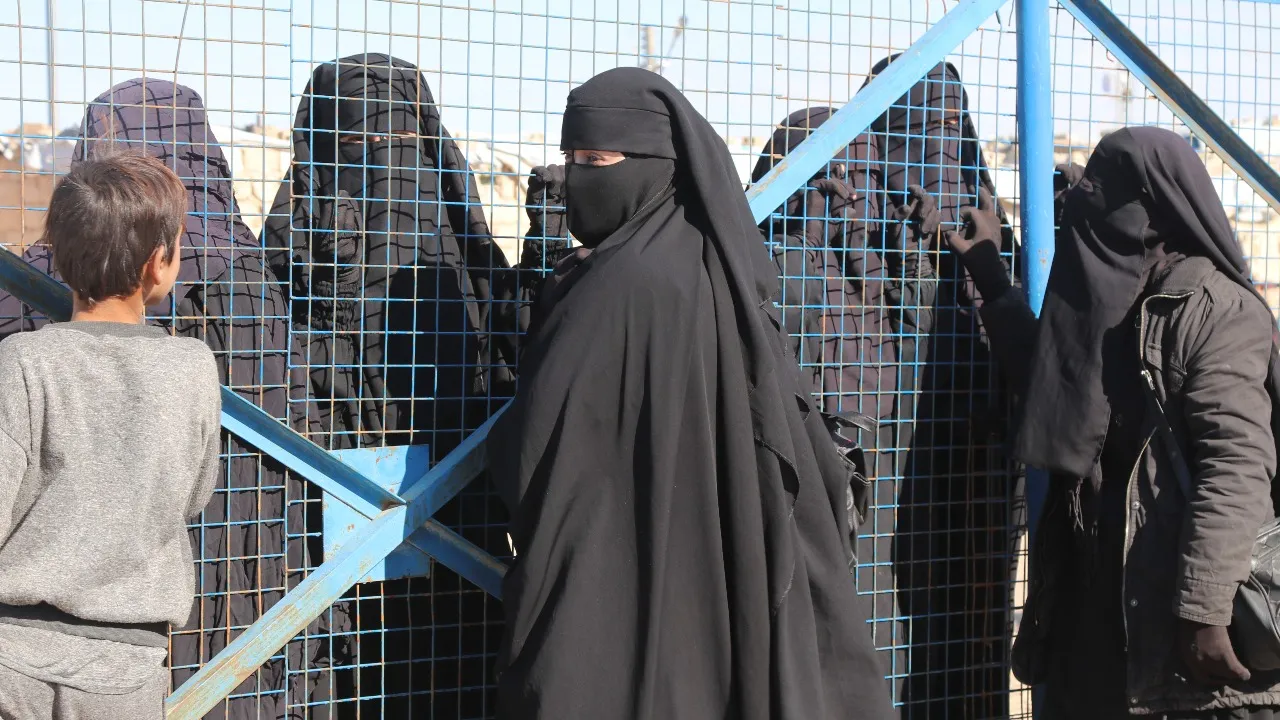European Centre for Counterterrorism and Intelligence Studies, Germany & Netherlands – ECCI
Counter Terrorism- ISIS infiltrated a refugee camp to recruit fighters
ISIS infiltrated a refugee camp to recruit fighters. Inside the Biden admin’s plan to stop it.
nbcnews – The Biden administration has enacted a new plan to reduce the population of a sprawling refugee camp near the Iraq-Syria border that has become a haven for the Islamic State terrorist group to recruit members, plot a comeback and carry out some of its most brutal tactics — including the torture and sexual abuse of women and girls — according to five senior administration officials.The core of the administration’s effort is to work with other nations to repatriate refugees from the al-Hol camp in rural Syria. The administration’s main focus is on Iraq, according to a U.S. military official and a Biden administration official. Six European countries and Australia have so far agreed to transport dozens of their citizens being held at the camp back to their homelands in the coming weeks, those officials said.
The Australian government, for instance, is already working to repatriate dozens of Australian citizens, mainly women and children related to ISIS fighters who are dead or in jail in Syria, according to the officials.Jason Koutsoukis, the senior media adviser for Australian Minister of Home Affairs Clare O’Neil, did not confirm the plans.“The government’s overriding priority is the protection of Australians and Australia’s national interests, informed by national security advice,” he said via email. “Given the sensitive nature of the matters involved, it would not be appropriate to comment further.”
The refugee camp, opened in 1991 during the first Gulf War, has exploded into a humanitarian disaster and a serious international terrorism threat. Officials in President Joe Biden’s administration told NBC News they have been alarmed by the speed with which the camp has grown to include tens of thousands of relatives of suspected ISIS members and became a breeding ground for people loyal to ISIS. The camp population lives in ragged, white tents, facing punishing desert heat and frigid cold at night. They have limited access to running water and poor sanitation. Children, who make up the majority of the residents, receive very little schooling, according to aid organizations like Save the Children. Parts of the camp are impossible to control and ISIS, with the help of thousands of women still thought to be loyal to the group, is recruiting new fighters by offering residents basic services or forcibly enlisting them with threats and violence, according to the U.S. military.
“This place is a literal breeding ground for the next generation of ISIS,” Gen. Michael “Erik” Kurilla, commander of U.S. Central Command, said in a statement after recently visiting al-Hol. “ISIS seeks to exploit these horrific conditions.”
The growing terrorism threat poses a political problem for Biden, threatening to undermine his vow not to allow ISIS to reconstitute. Biden has insisted the U.S. can continue to effectively fight terrorism despite an increasingly shrinking troop presence overseas, pointing to two operations this year: a raid by U.S. special forces in northwestern Syria that led to the death of ISIS’s top leader and a drone strike in Afghanistan that killed the head of al-Qaeda.The situation at al-Hol threatens to undermine all of that.“It’s a complex problem. There are humanitarian elements to it, but there’s a security element as well,” a senior administration official said. “We are trying to look for creative approaches and new energy and resources to get at this same problem that has been evolving over the last few years.”
In the past three years, al-Hol has grown from 10,000 to roughly 57,000 residents, about 90% of them are women and children , according to the U.S. government. About 40,000 of the children are under the age of 12, the government data says, and at least 80 babies are born there each month. And about 8,000 of the women are “jihadists and wives and widows of ISIS fighters” who have organized their own “religious police units,” the Carnegie Endowment for International Peace recently reported.
A recent, nearly three-week operation at al-Hol — conducted by the Syrian Democratic Forces, with the U.S. military providing intelligence and surveillance — found women and girls who were chained, tortured and sexually abused, according to the U.S. military. One Yazidi girl found inside a tent had been held captive by ISIS for eight years, routinely raped and sold as a slave since she was taken from her family in Iraq when she was 9. The operation led by the SDF, which is nominally in charge of the camp, resulted in the arrest of hundreds of ISIS fighters and the discovery of dozens of tunnels where the group’s operatives had stored weapons and supplies, including more than 50 pounds of explosives.
Administration officials are particularly worried that the tens of thousands of children at al-Hol are especially vulnerable to being recruited by ISIS, or forced to join. “We’re really concerned that al-Hol is deeply tied to one of our primary objectives for all of Syria, which is to prevent the resurgence of ISIS,” the senior administration official said.U.S. officials have said there is no military solution to al-Hol, and instead are trying to stop the growth of ISIS through diplomatic outreach. Officials at the State Department, National Security Council and Pentagon are working on the plan, which also includes improving living conditions for those who cannot leave.
The U.S. is adding the issue to diplomatic and military engagements, the five administration officials said, including asking every country with citizens at al-Hol what the hurdles are to repatriating them.“The United States supports and applauds recent repatriations,” a spokesperson for the NSC said in a statement. “Our effort to encourage repatriations and offer support is ongoing.”The NSC spokesperson deferred to the countries that have agreed to repatriate their citizens for comment on their efforts.
The camp’s size and makeup dramatically changed in March 2019 when the Syrian Democratic Forces defeated ISIS fighters at Baghouz, Syria. The battle there was seen as ISIS’ last stand, and its defeat marked the fall of the terrorist group’s self-proclaimed caliphate. Many ISIS fighters were killed, but some of them, as well as their family members and sympathizers, fled to al-Hol. Within weeks after the fall of Baghouz, the population at al-Hol doubled to more than 20,000.
It has continued to grow. Today, al-Hol includes multiple enclaves, including a separate space for women and children of ISIS fighters.One of the issues plaguing the Biden administration, and the Trump administration previously, is officials don’t have clarity on who precisely is at al-Hol. Residents don’t have to declare their nationality so estimates are rough and difficult to verify. Further complicating matters, some residents lie in order to be repatriated somewhere other than their home countries.
Of the roughly 57,000 residents there now, U.S. officials say an estimated 28,000 are from Iraq and 18,000 from Syria. They say another roughly 10,000 residents of al-Hol are foreign born, neither Syrian nor Iraqi.The U.S. has made efforts to repatriate all its citizens in the camp, but some countries have been reluctant to do the same despite years of U.S. efforts to convince them. Many of them don’t have passports or other documentation to prove their citizenship, and foreign governments are concerned they could be ISIS sympathizers or worse, former fighters who could pose a threat inside their countries.
“Most of the residents can and should be rehabilitated and returned to society. Just like all people, they wish to contribute to society and raise their families in peace,” Kurilla said in a statement. “Most of them reject and fear ISIS. Most wish to return safely to their homelands, to reenter the workforce and return their children to school.”Administration officials want to reduce the population at al-Hol to a manageable level that humanitarian aid groups and trained guards can handle. The officials would not put a specific number on that ideal population size, referring to when the camp held 5,600 to 10,000 residents.
Iraq has become the administration’s top priority for achieving that goal — nearly half of the residents at al-Hol are Iraqi citizens. Biden administration officials contend that if the government in Baghdad took back all Iraqi citizens at al-Hol, the problem would be far more manageable. Currently, the Iraqi government is working to repatriate several thousand of them, about 150 families. At that pace, it could take up to seven years for all the Iraqi citizens at al-Hol to return home.
Top U.S. diplomats and military officials are asking the Iraqis to speed up their efforts. But the Iraqi government has pointed out that some al-Hol residents cannot return to where they came from in Iraq so resettlement is not as easy as it might seem.The next largest population at al-Hol is even more complex — Syrian citizens who fled not just ISIS but also Syria’s Assad regime. They still cannot return home because the areas where they’re from are now controlled by the government or because they would be viewed as ISIS sympathizers.
Without any other country to go to, the Syrian population is the one that could remain in the camp the longest, administration officials say.The SDF, meanwhile, is enhancing security since the clearing operation earlier this month, according to the U.S. military. They’ve added fencing and more surveillance. But U.S. officials are concerned that the SDF’s attention could get pulled elsewhere given the continued fight against ISIS outside of al-Hol and the threat they’re under from Turkish forces.
SDF officials did not respond to requests for comment on the humanitarian and security situation in the camp. The U.S. is also urging countries to help address the deteriorating living and security conditions at the camp. “Our intent is to try to see if we can reinvigorate our efforts, and also look to see if there are some other approaches that perhaps we may have missed,” a senior administration official said.




